-
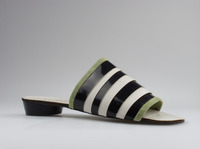 The Paper Shoes - Herbert Levine, Designed by Kathryn Stoll Paige
The Paper Shoes - Herbert Levine, Designed by Kathryn Stoll Paige One unsustainable material that made its way into fashion during the period was paper. As it was so readily available, and cheap in comparison to some materials, it is no wonder that paper began its debut into fashion. The choice to use vinyl and paper for fashion were a direct result of the need to innovate, and experiment with what is fashion. Experimental materials began creating a path for fashion that was unheard of yet. Even when combined with more traditional designs, these new materials created looks that went beyond what has been imagined before.
-
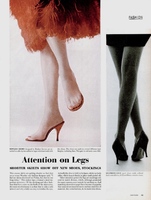 Attention On Legs, Beth & Herbert Levine - No Shoe (left)
Attention On Legs, Beth & Herbert Levine - No Shoe (left) “… of the stocking and shoe fashions that have come on the heels of the skirt news, the most revolutionary is a shoe that is only a sole and why a lady can stay in it defies the eye. “ -LIFE magazine
Levine’s Topless Shoes were another example of experimental fashion. These bold shoes break the expectations of what is a shoe, while also being revealing and sexy. Instead of being transparent like plastic, they just take away material in general. This shoe was called the “No shoe”, and it even came with an adhesive to keep the shoe on the wearer’s foot.
-
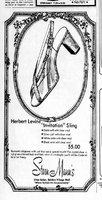 Ad for Herbert Levine “Invitation” shoes
Ad for Herbert Levine “Invitation” shoes Beth and Herbert Levine advertisements have drawn inspiration from the glass slipper. The ad in the middle reads: “The crystal-clear vinyl gives a bared look and feel; when its midnight, you’ll still be Cinderella in her finery.” Many shoes in the period, especially Herbert Levine, have taken ideas from the famous shoe. It is a classic design with a unique twist—revolutionary material.
-
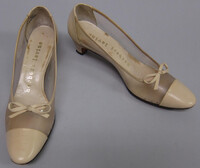 Beth Levine Shoes in the TFC 196u
Beth Levine Shoes in the TFC 196u
-
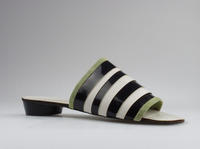 1967 Paper Shoes DL&SM Herbert Levine
1967 Paper Shoes DL&SM Herbert Levine
-
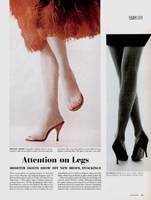 Beth and Herbert Levine No Shoe 1958
Life Magazine
Beth and Herbert Levine No Shoe 1958
Life Magazine
-
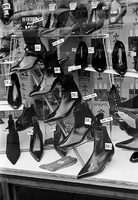 Liverpool Window Display
Liverpool Window Display This is a window display found in a Liverpool shoe store in the 1960s. The design aesthetics of the Beatle boot influenced the design of many boots. By looking at the photograph taken in Liverpool London of a window storefront, you can see the Beatle boot's influence through the pointed toe, Cuban heel, short style, and solid black leather in several different variations.
-
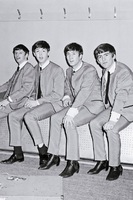 Beatles suit and Beatle boots
Beatles suit and Beatle boots The Beatles collarless suit was designed by Pierre Cardin. He began his career working under Christian Dior as a tailor for menswear. This carried over into his designs later into his career as "Cardin deconstructed the traditional business suit. He subtracted collars, cuffs, and lapels, creating one of the most compelling images of the early 1960s." This article of clothing became known as the collarless suit that was worn by the Beatles. The Beatles often wore these boots with the Chelsea boot, then became known as the Beatle boot. The Beatles took caught the eye of the world, and in turn, everything they wore was closely monitored. The Beatle's influence on fashion carried further than only the collarless suit and the Beatle boots.
-
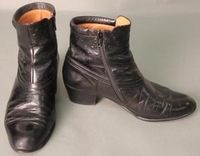 Pierre Cardin Beatle Boots
Pierre Cardin Beatle Boots Pierre Cardin created this pair of Men's short boots that were made in Spain. The primary material for this boot is black leather. The boots' design is slightly pointed toe, with a modified Cuban style with a one-inch heel. There is a zipper on the interior side of the boot. Through the wear in the leather, you can see that these boots were well-loved and worn often.
-
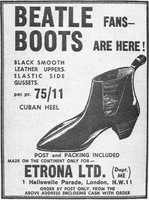 Beatle Boots Ad
Beatle Boots Ad The Beatles often wore these boots with the Chelsea boot, then became known as the Beatle boot. The Beatles took caught the eye of the world, and in turn, everything they wore was closely monitored. The Beatle's influence on fashion carried further than only the collarless suit and the Beatle boots. If you at the progression of the Beatles in the 1960's you can see it begin as "something somewhat normative becoming transgressive, becoming psychedelically lite from the drugs, becoming spiritual and withdrawn. That's the story of the '60s as it heads into the 70's".
Source:
Rolling Stone. “1960s Style, Trends Revisited: British Invasion, Hippies, Woodstock .” Rollingstone.com, October 17, 2017. https://www.rollingstone.com/culture/culture-news/ 1960s-style-trends-revisited-british-invasion-hippies-woodstock-120499/.
-
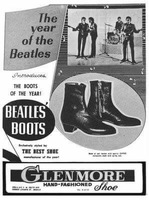 Beatle Boots Ad
Beatle Boots Ad The Beatles often wore these boots with the Chelsea boot, then became known as the Beatle boot. The Beatles took caught the eye of the world, and in turn, everything they wore was closely monitored.
The Beatle's influence on fashion carried further than only the collarless suit and the Beatle boots. If you at the progression of the Beatles in the 1960's you can see it begin as "something somewhat normative becoming transgressive, becoming psychedelically lite from the drugs, becoming spiritual and withdrawn. That's the story of the '60s as it heads into the 70's".
Source:
Rolling Stone. “1960s Style, Trends Revisited: British Invasion, Hippies, Woodstock .” Rollingstone.com, October 17, 2017. https://www.rollingstone.com/culture/culture-news/ 1960s-style-trends-revisited-british-invasion-hippies-woodstock-120499/.
-
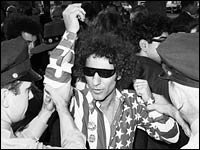 [Untitled]
[Untitled]
-
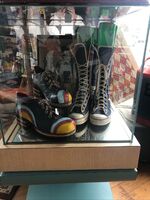 Flagg Bros Shoe Display
Flagg Bros Shoe Display Flagg Bros. ad for All American shoes (top right) and American flag high tops found in Massachusetts. (Provided by Ebay user douglasvaleri).
-
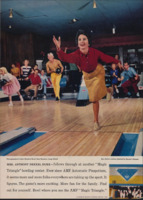 Bowling Ad from Harper's Bazaar.
Bowling Ad from Harper's Bazaar. Verfurth , Emily. “Strikes, Spares, and Gutter Balls: A History of Women's Bowling in Twentieth-Century America.,” 2012.
-
 Nixon
Nixon Baradaran, Mehrsa. “A Bad Check for Black America.” Boston Review, August 8, 2018. http://bostonreview.net/class-inequality-race/mehrsa-baradaran-bad-check-black-america.
-
 Richard Nixon
Richard Nixon
-
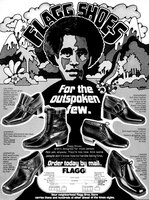 For the Outspoken Few
For the Outspoken Few Flagg Brothers advertisement featured in a 1970 Ebony Magazine. The center text "For the outspoken Few" is a clear indication of the niche community they hope to reach.
-
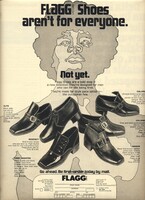 Flagg Shoes Aren't For Everyone
Flagg Shoes Aren't For Everyone Flagg Brothers advertisement featured in a 1970 Ebony Magazine. Notice the exclusive language in describing the shoes as "not for everyone" at least "not yet."
-
 Joe Barentine
Joe Barentine Image of a unique outfit by Joe Barentine 1970. This outfit includes the above-mentioned platform shoes.
-
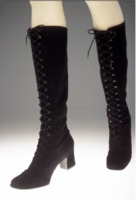 Charles Jourdan Boots
Charles Jourdan Boots
-
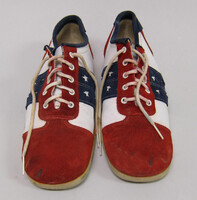 All American Shoe
All American Shoe Front view of the shoe.
-
 All American Shoe
All American Shoe Side View
-
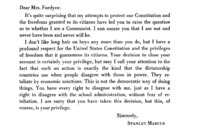 Excerpt from "Minding the Store"
Excerpt from "Minding the Store" A passage from Stanley Marcus' memoir, featuring a letter he wrote to defend his position on the issue of young men being able to wear long hair at school.
-
 Letter from Stanley Marcus
Letter from Stanley Marcus An Neiman Marcus advertisement featuring a letter from Stanley Marcus, responding to a young girl who enjoys shopping the Nonesuch brand with her big sisters.
-
 Nonesuch advertisement
Nonesuch advertisement An advertisement for a wedge shoe sold by Neiman Marcus under the in-house junior's brand Nonesuch.
 The Paper Shoes - Herbert Levine, Designed by Kathryn Stoll Paige One unsustainable material that made its way into fashion during the period was paper. As it was so readily available, and cheap in comparison to some materials, it is no wonder that paper began its debut into fashion. The choice to use vinyl and paper for fashion were a direct result of the need to innovate, and experiment with what is fashion. Experimental materials began creating a path for fashion that was unheard of yet. Even when combined with more traditional designs, these new materials created looks that went beyond what has been imagined before.
The Paper Shoes - Herbert Levine, Designed by Kathryn Stoll Paige One unsustainable material that made its way into fashion during the period was paper. As it was so readily available, and cheap in comparison to some materials, it is no wonder that paper began its debut into fashion. The choice to use vinyl and paper for fashion were a direct result of the need to innovate, and experiment with what is fashion. Experimental materials began creating a path for fashion that was unheard of yet. Even when combined with more traditional designs, these new materials created looks that went beyond what has been imagined before. Attention On Legs, Beth & Herbert Levine - No Shoe (left) “… of the stocking and shoe fashions that have come on the heels of the skirt news, the most revolutionary is a shoe that is only a sole and why a lady can stay in it defies the eye. “ -LIFE magazine Levine’s Topless Shoes were another example of experimental fashion. These bold shoes break the expectations of what is a shoe, while also being revealing and sexy. Instead of being transparent like plastic, they just take away material in general. This shoe was called the “No shoe”, and it even came with an adhesive to keep the shoe on the wearer’s foot.
Attention On Legs, Beth & Herbert Levine - No Shoe (left) “… of the stocking and shoe fashions that have come on the heels of the skirt news, the most revolutionary is a shoe that is only a sole and why a lady can stay in it defies the eye. “ -LIFE magazine Levine’s Topless Shoes were another example of experimental fashion. These bold shoes break the expectations of what is a shoe, while also being revealing and sexy. Instead of being transparent like plastic, they just take away material in general. This shoe was called the “No shoe”, and it even came with an adhesive to keep the shoe on the wearer’s foot. Ad for Herbert Levine “Invitation” shoes Beth and Herbert Levine advertisements have drawn inspiration from the glass slipper. The ad in the middle reads: “The crystal-clear vinyl gives a bared look and feel; when its midnight, you’ll still be Cinderella in her finery.” Many shoes in the period, especially Herbert Levine, have taken ideas from the famous shoe. It is a classic design with a unique twist—revolutionary material.
Ad for Herbert Levine “Invitation” shoes Beth and Herbert Levine advertisements have drawn inspiration from the glass slipper. The ad in the middle reads: “The crystal-clear vinyl gives a bared look and feel; when its midnight, you’ll still be Cinderella in her finery.” Many shoes in the period, especially Herbert Levine, have taken ideas from the famous shoe. It is a classic design with a unique twist—revolutionary material. Beth Levine Shoes in the TFC 196u
Beth Levine Shoes in the TFC 196u  1967 Paper Shoes DL&SM Herbert Levine
1967 Paper Shoes DL&SM Herbert Levine  Beth and Herbert Levine No Shoe 1958
Life Magazine
Beth and Herbert Levine No Shoe 1958
Life Magazine  Liverpool Window Display This is a window display found in a Liverpool shoe store in the 1960s. The design aesthetics of the Beatle boot influenced the design of many boots. By looking at the photograph taken in Liverpool London of a window storefront, you can see the Beatle boot's influence through the pointed toe, Cuban heel, short style, and solid black leather in several different variations.
Liverpool Window Display This is a window display found in a Liverpool shoe store in the 1960s. The design aesthetics of the Beatle boot influenced the design of many boots. By looking at the photograph taken in Liverpool London of a window storefront, you can see the Beatle boot's influence through the pointed toe, Cuban heel, short style, and solid black leather in several different variations. Beatles suit and Beatle boots The Beatles collarless suit was designed by Pierre Cardin. He began his career working under Christian Dior as a tailor for menswear. This carried over into his designs later into his career as "Cardin deconstructed the traditional business suit. He subtracted collars, cuffs, and lapels, creating one of the most compelling images of the early 1960s." This article of clothing became known as the collarless suit that was worn by the Beatles. The Beatles often wore these boots with the Chelsea boot, then became known as the Beatle boot. The Beatles took caught the eye of the world, and in turn, everything they wore was closely monitored. The Beatle's influence on fashion carried further than only the collarless suit and the Beatle boots.
Beatles suit and Beatle boots The Beatles collarless suit was designed by Pierre Cardin. He began his career working under Christian Dior as a tailor for menswear. This carried over into his designs later into his career as "Cardin deconstructed the traditional business suit. He subtracted collars, cuffs, and lapels, creating one of the most compelling images of the early 1960s." This article of clothing became known as the collarless suit that was worn by the Beatles. The Beatles often wore these boots with the Chelsea boot, then became known as the Beatle boot. The Beatles took caught the eye of the world, and in turn, everything they wore was closely monitored. The Beatle's influence on fashion carried further than only the collarless suit and the Beatle boots. Pierre Cardin Beatle Boots Pierre Cardin created this pair of Men's short boots that were made in Spain. The primary material for this boot is black leather. The boots' design is slightly pointed toe, with a modified Cuban style with a one-inch heel. There is a zipper on the interior side of the boot. Through the wear in the leather, you can see that these boots were well-loved and worn often.
Pierre Cardin Beatle Boots Pierre Cardin created this pair of Men's short boots that were made in Spain. The primary material for this boot is black leather. The boots' design is slightly pointed toe, with a modified Cuban style with a one-inch heel. There is a zipper on the interior side of the boot. Through the wear in the leather, you can see that these boots were well-loved and worn often. Beatle Boots Ad The Beatles often wore these boots with the Chelsea boot, then became known as the Beatle boot. The Beatles took caught the eye of the world, and in turn, everything they wore was closely monitored. The Beatle's influence on fashion carried further than only the collarless suit and the Beatle boots. If you at the progression of the Beatles in the 1960's you can see it begin as "something somewhat normative becoming transgressive, becoming psychedelically lite from the drugs, becoming spiritual and withdrawn. That's the story of the '60s as it heads into the 70's". Source: Rolling Stone. “1960s Style, Trends Revisited: British Invasion, Hippies, Woodstock .” Rollingstone.com, October 17, 2017. https://www.rollingstone.com/culture/culture-news/ 1960s-style-trends-revisited-british-invasion-hippies-woodstock-120499/.
Beatle Boots Ad The Beatles often wore these boots with the Chelsea boot, then became known as the Beatle boot. The Beatles took caught the eye of the world, and in turn, everything they wore was closely monitored. The Beatle's influence on fashion carried further than only the collarless suit and the Beatle boots. If you at the progression of the Beatles in the 1960's you can see it begin as "something somewhat normative becoming transgressive, becoming psychedelically lite from the drugs, becoming spiritual and withdrawn. That's the story of the '60s as it heads into the 70's". Source: Rolling Stone. “1960s Style, Trends Revisited: British Invasion, Hippies, Woodstock .” Rollingstone.com, October 17, 2017. https://www.rollingstone.com/culture/culture-news/ 1960s-style-trends-revisited-british-invasion-hippies-woodstock-120499/. Beatle Boots Ad The Beatles often wore these boots with the Chelsea boot, then became known as the Beatle boot. The Beatles took caught the eye of the world, and in turn, everything they wore was closely monitored. The Beatle's influence on fashion carried further than only the collarless suit and the Beatle boots. If you at the progression of the Beatles in the 1960's you can see it begin as "something somewhat normative becoming transgressive, becoming psychedelically lite from the drugs, becoming spiritual and withdrawn. That's the story of the '60s as it heads into the 70's". Source: Rolling Stone. “1960s Style, Trends Revisited: British Invasion, Hippies, Woodstock .” Rollingstone.com, October 17, 2017. https://www.rollingstone.com/culture/culture-news/ 1960s-style-trends-revisited-british-invasion-hippies-woodstock-120499/.
Beatle Boots Ad The Beatles often wore these boots with the Chelsea boot, then became known as the Beatle boot. The Beatles took caught the eye of the world, and in turn, everything they wore was closely monitored. The Beatle's influence on fashion carried further than only the collarless suit and the Beatle boots. If you at the progression of the Beatles in the 1960's you can see it begin as "something somewhat normative becoming transgressive, becoming psychedelically lite from the drugs, becoming spiritual and withdrawn. That's the story of the '60s as it heads into the 70's". Source: Rolling Stone. “1960s Style, Trends Revisited: British Invasion, Hippies, Woodstock .” Rollingstone.com, October 17, 2017. https://www.rollingstone.com/culture/culture-news/ 1960s-style-trends-revisited-british-invasion-hippies-woodstock-120499/. [Untitled]
[Untitled]  Flagg Bros Shoe Display Flagg Bros. ad for All American shoes (top right) and American flag high tops found in Massachusetts. (Provided by Ebay user douglasvaleri).
Flagg Bros Shoe Display Flagg Bros. ad for All American shoes (top right) and American flag high tops found in Massachusetts. (Provided by Ebay user douglasvaleri). Bowling Ad from Harper's Bazaar. Verfurth , Emily. “Strikes, Spares, and Gutter Balls: A History of Women's Bowling in Twentieth-Century America.,” 2012.
Bowling Ad from Harper's Bazaar. Verfurth , Emily. “Strikes, Spares, and Gutter Balls: A History of Women's Bowling in Twentieth-Century America.,” 2012. Nixon Baradaran, Mehrsa. “A Bad Check for Black America.” Boston Review, August 8, 2018. http://bostonreview.net/class-inequality-race/mehrsa-baradaran-bad-check-black-america.
Nixon Baradaran, Mehrsa. “A Bad Check for Black America.” Boston Review, August 8, 2018. http://bostonreview.net/class-inequality-race/mehrsa-baradaran-bad-check-black-america. Richard Nixon
Richard Nixon  For the Outspoken Few Flagg Brothers advertisement featured in a 1970 Ebony Magazine. The center text "For the outspoken Few" is a clear indication of the niche community they hope to reach.
For the Outspoken Few Flagg Brothers advertisement featured in a 1970 Ebony Magazine. The center text "For the outspoken Few" is a clear indication of the niche community they hope to reach. Flagg Shoes Aren't For Everyone Flagg Brothers advertisement featured in a 1970 Ebony Magazine. Notice the exclusive language in describing the shoes as "not for everyone" at least "not yet."
Flagg Shoes Aren't For Everyone Flagg Brothers advertisement featured in a 1970 Ebony Magazine. Notice the exclusive language in describing the shoes as "not for everyone" at least "not yet." Joe Barentine Image of a unique outfit by Joe Barentine 1970. This outfit includes the above-mentioned platform shoes.
Joe Barentine Image of a unique outfit by Joe Barentine 1970. This outfit includes the above-mentioned platform shoes. Charles Jourdan Boots
Charles Jourdan Boots
 All American Shoe Front view of the shoe.
All American Shoe Front view of the shoe. All American Shoe Side View
All American Shoe Side View Excerpt from "Minding the Store" A passage from Stanley Marcus' memoir, featuring a letter he wrote to defend his position on the issue of young men being able to wear long hair at school.
Excerpt from "Minding the Store" A passage from Stanley Marcus' memoir, featuring a letter he wrote to defend his position on the issue of young men being able to wear long hair at school. Letter from Stanley Marcus An Neiman Marcus advertisement featuring a letter from Stanley Marcus, responding to a young girl who enjoys shopping the Nonesuch brand with her big sisters.
Letter from Stanley Marcus An Neiman Marcus advertisement featuring a letter from Stanley Marcus, responding to a young girl who enjoys shopping the Nonesuch brand with her big sisters. Nonesuch advertisement An advertisement for a wedge shoe sold by Neiman Marcus under the in-house junior's brand Nonesuch.
Nonesuch advertisement An advertisement for a wedge shoe sold by Neiman Marcus under the in-house junior's brand Nonesuch.